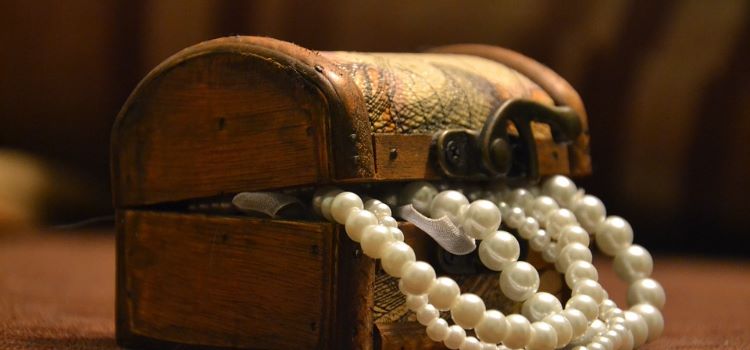Greetings, my fellow jewelry enthusiasts! Today, I want to delve into the fascinating world of sterling silver and allergies. Many of us with sensitive skin have wondered, “Is sterling silver hypoallergenic?” Well, fret no more! In this friendly guide, I’m here to shed light on this topic and help you make an informed decision.
Whether you have sterling silver allergies or simply want to explore hypoallergenic jewelry options for your sensitive skin, I’ve got you covered. So, let’s dive in and discover the ins and outs of this sparkling metal!
What Does Hypoallergenic Mean?
Hypoallergenic refers to products that are unlikely to cause allergic reactions. When it comes to skin reactions, hypoallergenic is a term that often comes up in discussions about silver jewelry and clothing.
For those with sensitive skin, finding hypoallergenic products is important. In the case of silver jewelry, it means finding options that are less likely to cause skin irritation or allergic reactions. But what does hypoallergenic really mean? Let’s explore this term further to understand its significance.
To put it simply, hypoallergenic products are designed to minimize the risk of triggering allergic reactions in individuals with sensitivities. While hypoallergenic does not guarantee that a product will never cause a reaction in anyone, it means that the likelihood of such reactions is significantly reduced.
“Hypoallergenic refers to products that are unlikely to cause allergic reactions.”
When it comes to silver jewelry, hypoallergenic options are particularly sought after. Many individuals experience skin reactions when wearing certain metals, such as nickel. Hypoallergenic silver jewelry aims to minimize these reactions, making it a safer option for those with sensitive skin.
Now that we understand what hypoallergenic means, let’s delve deeper into the hypoallergenic properties of different types of silver, specifically sterling silver, and its suitability for individuals with sensitive skin.
Is All Silver Hypoallergenic?
When it comes to the hypoallergenic properties of silver, it’s important to understand that not all types of silver are created equal. While pure silver is hypoallergenic, it is too soft for use in jewelry. That’s where sterling silver comes in. Sterling silver is an alloy made up of 92.5% pure silver and 7.5% other metals, usually copper. This combination of metals makes sterling silver not only durable but also hypoallergenic, making it a safe choice for those with sensitive skin.
One of the key reasons why sterling silver is hypoallergenic is because of the copper content in the alloy. Copper itself is a hypoallergenic metal, meaning it is unlikely to cause allergic reactions. So even if a person has a metal allergy, they are less likely to react to sterling silver due to the presence of copper. It’s worth noting that other metals like germanium, platinum, silicon, and zinc can also be used in sterling silver alloys, further enhancing its hypoallergenic properties.
To summarize, while pure silver may not be suitable for those with sensitive skin, sterling silver is a hypoallergenic alternative. The presence of copper, and potentially other hypoallergenic metals, makes it safe for individuals prone to metal allergies. So if you’re looking for a beautiful, durable, and hypoallergenic choice for your jewelry, sterling silver is an excellent option to consider.
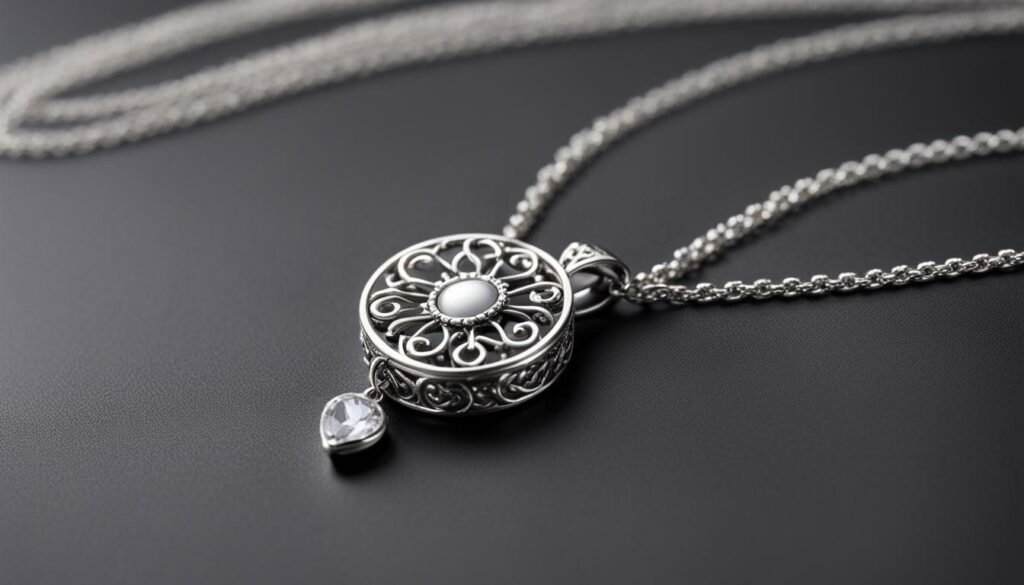
| Silver Type | Composition | Hypoallergenic |
|---|---|---|
| Pure Silver | 99.9% Silver | Yes |
| Sterling Silver | 92.5% Silver, 7.5% Copper (or other metals) | Yes |
| Silver Plating | Thin layer of silver over base metal | Depends on base metal |
| Silver Filling | Thick layer of silver over base metal | Depends on base metal |
Understanding Metal Allergies and Allergic Reactions to Jewelry
Metal allergies, especially those related to nickel, are relatively common. In fact, up to 17% of women and 3% of men have some form of metal allergy. These allergies can cause allergic reactions when individuals come into contact with certain metals, such as those found in jewelry.
Allergic reactions to jewelry can manifest in various ways, including rashes, itching, redness, and swelling. These symptoms can range from mild to severe, depending on the individual’s sensitivity to the metal. It is important to understand the potential risks associated with metal allergies when considering wearing jewelry, including sterling silver.
While sterling silver is generally hypoallergenic, it can still cause reactions in some individuals. This is often due to the presence of allergenic metals like nickel in the alloy. Copper is commonly used as the alloy metal in sterling silver, and it is generally hypoallergenic. However, if the jewelry contains allergy-causing metals like nickel, it can trigger allergic reactions in those with sensitivities.

Table: Common Symptoms of Metal Allergies
| Allergy Symptoms | Description |
|---|---|
| Rashes | Red, itchy patches of skin |
| Itching | Uncomfortable sensation on the skin |
| Redness | Visible discoloration of the skin |
| Swelling | Puffiness or enlargement of affected area |
It is important to be aware of these symptoms and take precautions when wearing jewelry, especially if you have a known metal allergy or sensitivity. If you experience any of these symptoms, it is recommended to remove the jewelry and consult with a dermatologist or healthcare professional for appropriate treatment and advice.
Why Do Some People React to Sterling Silver?
Sterling silver is generally considered hypoallergenic, making it a safe choice for individuals with sensitive skin. However, some people may still experience reactions when wearing sterling silver jewelry. This can be attributed to the presence of certain metals in the alloy, such as nickel or other allergens. In addition to copper, which is commonly used in sterling silver, other metals like germanium, platinum, silicon, and zinc can also be found in the alloy.
If sterling silver jewelry contains allergy-causing metals like nickel, it can cause reactions in sensitive individuals. Nickel is a common allergen and can trigger skin irritations and allergic responses. Therefore, it is important for those with known nickel allergies to choose nickel-free sterling silver or opt for alternative hypoallergenic metals.
Table: Metals Used in Sterling Silver Alloys
| Metal | Allergenic Potential |
|---|---|
| Copper | Hypoallergenic |
| Germanium | May cause reactions in some individuals |
| Nickel | Common allergen, may cause reactions in sensitive individuals |
| Platinum | Generally hypoallergenic |
| Silicon | May cause reactions in some individuals |
| Zinc | May cause reactions in some individuals |
It’s important to note that the presence of these metals in sterling silver alloys can vary depending on the specific jewelry piece and manufacturer. To ensure the highest level of hypoallergenic properties, individuals with sensitivities should choose sterling silver jewelry that is labeled as nickel-free and purchase from reputable jewelers.
Overall, while sterling silver is generally hypoallergenic, it’s essential to understand your own allergic triggers and choose jewelry that suits your specific needs. Exploring alternative hypoallergenic metals like gold, platinum, rhodium, argentium, titanium, and surgical stainless steel can also provide additional options for those with metal allergies.
Differentiating Silver Plating and Silver Filling
When it comes to silver jewelry, you may have come across terms like “silver plating” and “silver filling.” These terms refer to different techniques used in creating jewelry and can affect the hypoallergenic properties of the piece.
Silver plating involves covering a base metal with a thin layer of silver. This layer can wear away over time, exposing the base metal underneath. On the other hand, silver filling involves a thicker layer of silver, which provides more durability compared to silver plating. However, over time, the base metal can still be exposed.
If you have sensitive skin or allergies, it’s important to note that both silver-plated and silver-filled jewelry can potentially cause allergic reactions if the base metal contains allergenic substances. It’s crucial to be aware of the materials used in the base metal to make an informed decision about purchasing and wearing such jewelry.
| Silver Plating | Silver Filling |
|---|---|
| Thin layer of silver | Thicker layer of silver |
| Base metal can be exposed over time | Base metal can also be exposed over time |
| Potential for allergic reactions if the base metal contains allergenic substances | Potential for allergic reactions if the base metal contains allergenic substances |
When choosing silver jewelry, it’s essential to consider your personal preferences, budget, and any allergies or sensitivities you may have. If you’re unsure about the materials used in a particular piece, it’s always best to consult with a reputable jeweler who can provide you with accurate information and guide you towards hypoallergenic options.
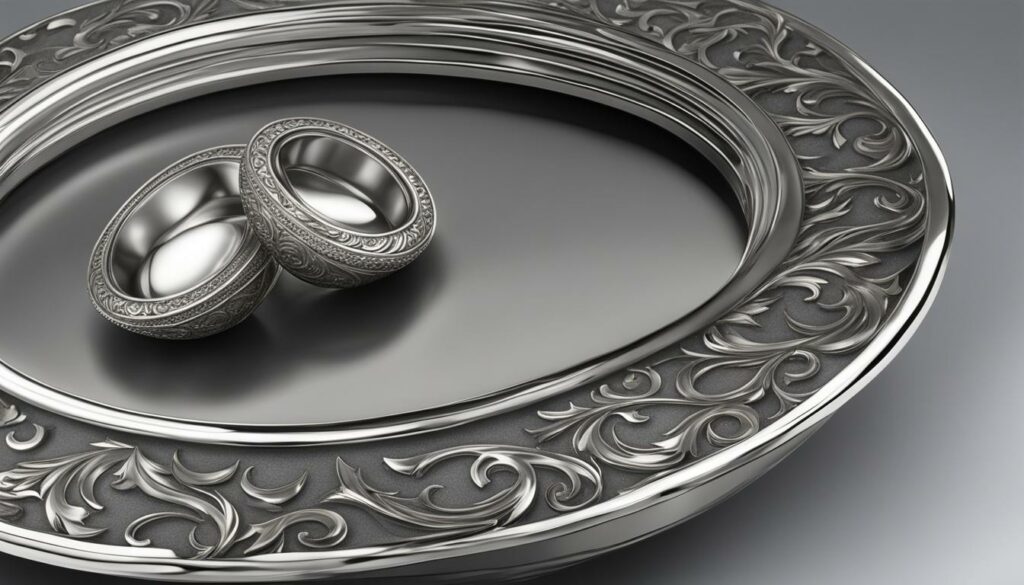
The Symptoms of Metal Allergies
Metal allergies can cause various symptoms, including rash, itching, redness, and swelling. These symptoms are often the result of an allergic reaction when the skin comes into contact with certain metals. If you have sensitive skin, it’s important to be aware of the signs of metal allergies to identify any potential reactions to sterling silver or other metals.
Here are some common symptoms associated with metal allergies:
- Rash: A red or bumpy rash may appear on the skin that has come into contact with the metal.
- Itching: Itching or a tingling sensation may occur in the affected area.
- Redness: The skin may become red and inflamed in reaction to the metal.
- Swelling: Swelling may occur around the area of contact with the metal.
If you experience any of these symptoms after wearing jewelry or coming into contact with metal objects, it is possible that you have a metal allergy. It is recommended to consult with a dermatologist or allergist for a proper diagnosis and guidance on managing metal allergies.
Treating Metal Allergy Reactions
If you experience a metal allergy reaction, there are steps you can take to alleviate the symptoms. It’s important to treat your skin gently and avoid further irritation. Here are some tips to help you manage metal allergy reactions:
- Apply a cool compress: Use a clean cloth soaked in cold water or an ice pack wrapped in a cloth to reduce itching and swelling. Gently apply the compress to the affected area for 15-20 minutes at a time.
- Use a soothing lotion: Look for lotions or creams specifically formulated for sensitive or irritated skin. These products often contain ingredients like aloe vera or chamomile, which can help calm the skin and provide relief.
- Moisturize regularly: Keeping your skin well-hydrated can help reduce dryness and itching. Choose a hypoallergenic moisturizer or an emollient cream to lock in moisture and protect your skin’s natural barrier.
It’s important to remember that these measures may provide temporary relief, but they may not eliminate the allergic reaction entirely. If your symptoms persist or worsen, it’s advisable to consult with a dermatologist or allergist for further evaluation and guidance.

| Tip | Benefit |
|---|---|
| Apply a cool compress | Reduces itching and swelling |
| Use a soothing lotion | Calms the skin and provides relief |
| Moisturize regularly | Reduces dryness and itching |
The Hypoallergenic Nature of Sterling Silver
When it comes to jewelry for individuals with sensitive skin, the question of hypoallergenic properties arises. Sterling silver, in general, is considered hypoallergenic, making it a safe option for those prone to allergic reactions. However, it is essential to ensure that the sterling silver jewelry is nickel-free, as nickel is a common allergen.
Nickel-free sterling silver is an excellent choice for individuals with allergies, as it eliminates the risk of any potential allergic reactions. By choosing nickel-free sterling silver from a reputable jeweler, you can enjoy the beauty and elegance of this metal without any worries. It is worth noting that other hypoallergenic metals, such as gold, platinum, rhodium, argentium, titanium, and surgical stainless steel, can also be considered for jewelry.
Table:
The table below provides a comparison of hypoallergenic metals commonly used in jewelry:
| Metal | Hypoallergenic |
|---|---|
| Sterling Silver | Yes (when nickel-free) |
| Gold | Yes (14-carat and higher) |
| Platinum | Yes |
| Rhodium | Yes |
| Argentium | Yes |
| Titanium | Yes |
| Surgical Stainless Steel | Yes |
Choosing the right hypoallergenic metal for your jewelry can ensure that you can wear it without any allergic reactions or discomfort. It’s always advisable to consult with a professional jeweler and inform them about any sensitivities or allergies you may have. With proper care and maintenance, hypoallergenic sterling silver jewelry can be a long-lasting and beautiful accessory for individuals with sensitive skin.
Caring for Sterling Silver Jewelry
Proper care is essential to maintain the longevity and beauty of sterling silver jewelry. Follow these tips to ensure your pieces stay in excellent condition:
- Avoid exposing your sterling silver jewelry to water, as it can cause tarnishing and damage. Remove your jewelry before swimming, showering, or doing household chores involving water.
- Store your sterling silver jewelry in airtight bags or containers to prevent oxidation and tarnishing. Keep them away from direct light and humidity.
- Remove your sterling silver jewelry when applying lotions, perfumes, or other chemicals that can affect its appearance. These substances can cause discoloration or damage to the metal.
- If you engage in activities that may risk damaging your jewelry, such as sports or heavy lifting, it is advisable to remove your sterling silver pieces to prevent scratches or dents.
- Regularly polish your sterling silver jewelry using a soft, non-abrasive microfiber cloth. Gently rub the surface to restore its shine and remove any tarnish that may have developed.
By following these care instructions, you can prolong the life of your sterling silver jewelry and keep it looking as good as new. Remember, prevention and regular maintenance are key to preserving its beauty.
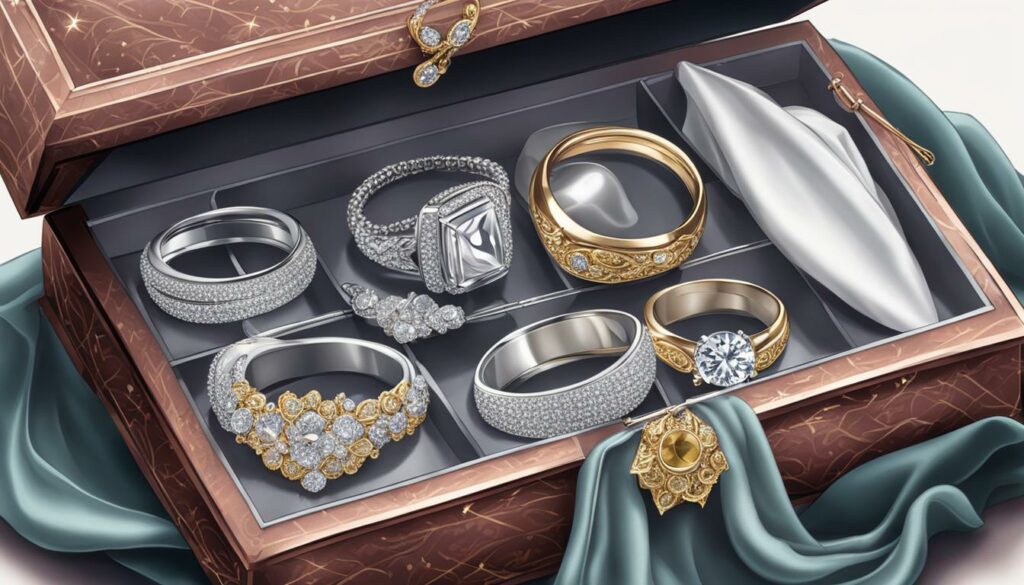
Table: Do’s and Don’ts for Sterling Silver Care
| Do | Don’t |
|---|---|
| Store in airtight containers | Expose to water |
| Remove before applying lotions or chemicals | Wear during activities that may damage it |
| Regularly polish with a microfiber cloth | Store in a humid environment |
Exploring Other Hypoallergenic Options
While sterling silver is a popular choice for hypoallergenic jewelry, there are other precious metals that offer hypoallergenic properties. Here are some options to consider:
- Gold: 14-carat gold or higher can be hypoallergenic, as it contains a lower percentage of allergenic metals like nickel. This makes it a safe choice for those with sensitive skin.
- Platinum: Platinum is a hypoallergenic metal that is often used in high-quality jewelry. It is durable, resistant to tarnish, and suitable for individuals with metal allergies.
- Rhodium: Rhodium is a popular choice for plating jewelry due to its hypoallergenic properties. It provides a glossy white finish and helps protect the underlying metal.
- Argentium: Argentium silver is a modern alloy that contains a higher percentage of pure silver. It is highly tarnish-resistant and hypoallergenic, making it an excellent option for those with sensitive skin.
- Titanium: Titanium is a lightweight and hypoallergenic metal often used in jewelry. It is corrosion-resistant, durable, and comfortable to wear, making it suitable for individuals with metal allergies.
- Surgical Stainless Steel: Surgical stainless steel is a hypoallergenic metal that is commonly used in body jewelry. It is highly resistant to corrosion and ideal for individuals with metal sensitivities.
Each of these metals has its own unique properties and benefits, allowing individuals with sensitive skin to find hypoallergenic options that suit their style and preferences. When choosing jewelry, it’s essential to consider the metal composition and opt for reputable sources that offer hypoallergenic options.
Remember, hypoallergenic precious metals like gold, platinum, rhodium, argentium, titanium, and surgical stainless steel provide alternatives to sterling silver for individuals with metal allergies. Explore these options to find the perfect hypoallergenic jewelry that suits your style and keeps your skin safe.
Now, let’s take a closer look at sterling silver allergies and the challenges posed by nickel allergies in the next section.
| Hypoallergenic Metal | Properties |
|---|---|
| Gold | Hypoallergenic when 14-carat or higher; contains a lower percentage of allergenic metals. |
| Platinum | Hypoallergenic, durable, resistant to tarnish. |
| Rhodium | Hypoallergenic, glossy white finish, protects underlying metal. |
| Argentium | Hypoallergenic, highly tarnish-resistant, contains higher percentage of pure silver. |
| Titanium | Hypoallergenic, lightweight, corrosion-resistant. |
| Surgical Stainless Steel | Hypoallergenic, highly corrosion-resistant, commonly used in body jewelry. |
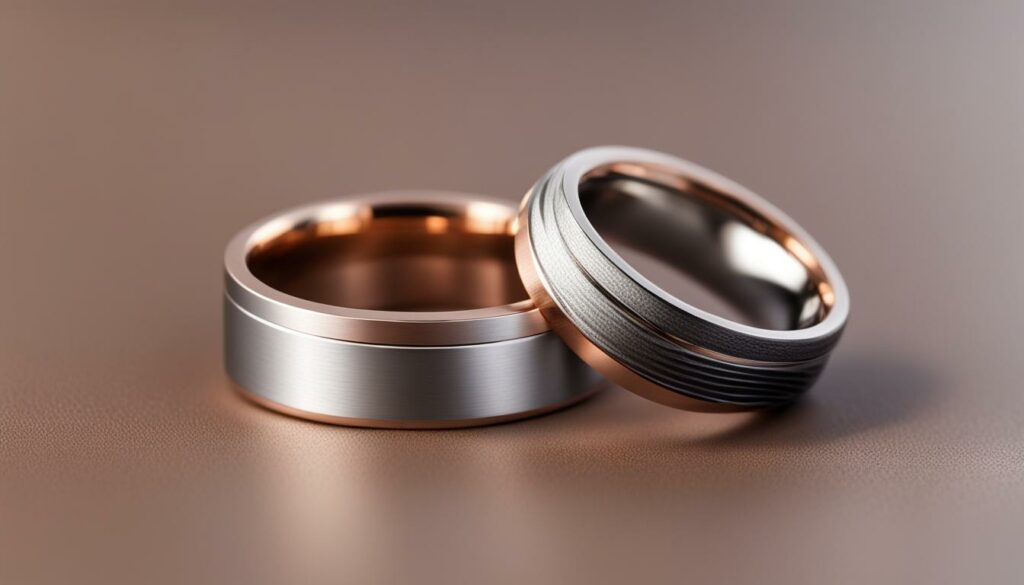
The Challenges of Nickel Allergies
If you have a nickel allergy, wearing jewelry can be a tricky task. Nickel is a common allergen and can cause allergic reactions in up to 20% of the population. When in direct contact with nickel-containing jewelry, individuals with a nickel allergy may experience symptoms such as rashes, itching, and redness. To avoid these reactions, it’s important to choose nickel-free jewelry labeled as hypoallergenic. However, there can be confusion and challenges in identifying truly hypoallergenic options.
When purchasing jewelry, it’s common to find items labeled as “nickel-free” or “hypoallergenic.” However, it’s important to note that these terms are not regulated, and there is no guarantee that the jewelry is truly free of nickel. Some manufacturers may still use nickel in the production process, leading to false claims of hypoallergenicity. To ensure you’re getting nickel-free jewelry, it’s best to rely on reputable sources and jewelers who can provide certifications or guarantees of the metal’s composition.
To address the concerns of individuals with nickel allergies, solid sterling silver jewelry is often recommended as a safe option. Sterling silver is typically made of 92.5% pure silver and 7.5% other metals, commonly copper. Reputable jewelers use copper as the alloy metal, ensuring the absence of nickel. However, it’s important to note that some overseas production may still incorporate nickel in their sterling silver jewelry. Therefore, it’s crucial to choose solid sterling silver from trusted sources to avoid any allergic reactions.

| Challenges of Nickel Allergies | Key Points |
|---|---|
| Prevalence | Nickel allergies affect up to 20% of the population |
| Symptoms | Rashes, itching, and redness when in direct contact with nickel-containing jewelry |
| Regulations | Terms like “nickel-free” and “hypoallergenic” are not regulated, leading to confusion and false claims |
| Choosing Nickel-Free Options | Look for reputable sources and jewelers who can provide certifications or guarantees |
| Solid Sterling Silver | Consider solid sterling silver jewelry, ensuring it is sourced from trusted manufacturers |
Opting for Solid Sterling Silver
When it comes to choosing jewelry for individuals with a nickel allergy, solid sterling silver is often a safe and hypoallergenic option. Reputable jewelers use copper as the alloy metal in sterling silver, ensuring the absence of nickel, which can cause allergic reactions. However, it’s important to be cautious when purchasing solid sterling silver jewelry, especially if it’s manufactured overseas.
In some overseas production, manufacturers may use nickel as part of the alloy, which can still trigger allergic reactions. To avoid any issues, it’s crucial to choose solid sterling silver jewelry from trusted sources that guarantee nickel-free pieces. By opting for nickel-free sterling silver jewelry, you can enjoy the beauty and elegance of silver without worrying about any unwanted skin reactions.
Trusted jewelers prioritize the use of copper in sterling silver jewelry, ensuring its hypoallergenic nature. Copper is a hypoallergenic metal that doesn’t cause adverse reactions in most individuals. So when you choose solid sterling silver jewelry with copper as the alloy metal, you can confidently wear it without any concerns about allergies or skin irritations.
| Sterling Silver Jewelry: | Nickel-Free: | Alloy Metal: | Country of Production: |
|---|---|---|---|
| Bracelet | Yes | Copper | USA |
| Earrings | Yes | Copper | USA |
| Necklace | Yes | Copper | USA |
| Ring | Yes | Copper | USA |
When it comes to purchasing solid sterling silver jewelry, look for reputable jewelers that prioritize nickel-free production and use copper as the alloy metal. By doing so, you can confidently wear sterling silver jewelry without worrying about allergic reactions, ensuring both style and comfort for individuals with sensitive skin.
Conclusion
In conclusion, sterling silver is generally considered hypoallergenic, making it a suitable choice for individuals with sensitive skin. Its composition of 92.5% pure silver and 7.5% other metals, commonly copper, ensures a low risk of allergic reactions. However, it’s essential to be aware of any potential allergens present in the alloy, such as nickel.
Understanding metal allergies is crucial in choosing jewelry that won’t cause discomfort. While sterling silver is a popular option, individuals with severe nickel allergies may need to explore alternative hypoallergenic metals like gold, platinum, rhodium, argentium, titanium, or surgical stainless steel.
Remember to care for your sterling silver jewelry properly to maintain its beauty and longevity. Avoid exposing it to water, store it in airtight bags away from light, remove it during chemical exposure or activities that may cause damage, and regularly polish it with a microfiber cloth.
By understanding metal allergies, exploring alternative hypoallergenic options, and following proper care guidelines, you can find the perfect jewelry that suits your sensitivities without compromising on style or quality.
FAQ
Is sterling silver hypoallergenic?
Yes, sterling silver is generally hypoallergenic. However, individuals with allergies may still react to it if there are allergenic metals present in the alloy, such as nickel.
What does hypoallergenic mean?
Hypoallergenic refers to products that are unlikely to cause allergic reactions. In the case of jewelry, hypoallergenic means that wearing it is less likely to cause skin reactions, especially for those with sensitive skin.
Is all silver hypoallergenic?
Pure silver is hypoallergenic, but it is too soft for use in jewelry. Sterling silver, which is an alloy of 92.5% pure silver and 7.5% other metals like copper, is commonly used in jewelry and is also hypoallergenic.
What are metal allergies?
Metal allergies are allergic reactions that can occur when the skin comes into contact with certain metals, most commonly nickel. These allergies can cause symptoms like rashes, itching, redness, and swelling.
Why do some people react to sterling silver?
While sterling silver is generally hypoallergenic, some individuals may still react to it if there are allergenic metals in the alloy, such as nickel. Other metals like copper, germanium, platinum, silicon, and zinc can also be used in sterling silver jewelry.
What is the difference between silver plating and silver filling?
Silver-plated jewelry has a thin layer of silver over a base metal, while silver-filled jewelry has a thicker layer of silver. Both types of jewelry can potentially cause allergic reactions if the base metal contains allergenic substances.
What are the symptoms of metal allergies?
Metal allergy symptoms can include rashes, itching, redness, and swelling. The severity of these symptoms can vary depending on the individual’s sensitivity to the metal.
How can metal allergy reactions be treated?
Treating metal allergy reactions can involve applying a cool compress, using a soothing lotion, and regularly moisturizing the affected area. It’s important to be gentle with the skin and avoid further irritation.
Can I wear sterling silver if I have sensitive skin?
Yes, sterling silver is generally considered safe for individuals with sensitive skin. However, it’s important to choose nickel-free sterling silver from reputable jewelers to ensure the highest level of hypoallergenic properties.
How should I care for my sterling silver jewelry?
To maintain the longevity of your sterling silver jewelry, it’s recommended to avoid exposing it to water, store it in airtight bags away from light, remove it when in contact with chemicals or during activities that may cause damage, and regularly polish it using a microfiber cloth.
Are there other hypoallergenic options for jewelry?
Yes, there are other hypoallergenic metals that can be considered for jewelry, such as gold (especially 14-carat or higher), platinum, rhodium, argentium, titanium, and surgical stainless steel. Each of these metals has its own unique properties and benefits.
What should I do if I have a nickel allergy?
If you have a nickel allergy, it’s important to avoid wearing jewelry that contains nickel. When purchasing items labeled as “nickel-free” or “hypoallergenic,” be cautious as there are no standardized regulations for these terms. Opting for solid sterling silver jewelry from trusted sources is a safe choice.
Source Links
- https://clothedwithtruth.com/blogs/news/nickel-free-hypoallergenic-sterling-silver-jewelry
- https://www.monicavinader.com/us/blog/news-and-events/is-sterling-silver-hypoallergenic
- https://www.philophrosyne.com/blogs/jewelry-guide/is-sterling-silver-hypoallergenic

Hey Fashion Enthusiasts! My wife Chantal and I, have been so fortunate to be able to share our latest inspiration and trends in the jewelry and accessory industry, and more so, to get this amazing feedback from our ever growing community. Where my wife focusses more on all things rings, weddings and female jewelry, I love to scoop out the newest accessories for men. I roam around the world to find the latest watches, bags, sunglasses, scarfs, wallets, you name it and I’ll deliver! I always commit to doing a lot of research to share my reviews and personalized advice on this blog or on our store. If you do not know what to wear, send me an email and I will help you out!




